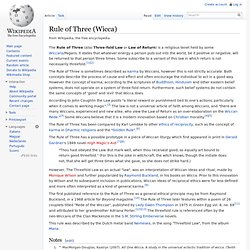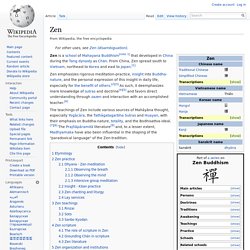

Spirituality. The term "spirituality" lacks a definitive definition, although social scientists have defined spirituality as the search for "the sacred," where "the sacred" is broadly defined as that which is set apart from the ordinary and worthy of veneration.

Definition[edit] How Meditation Affects The Brain. Humans have mediated for thousands of years, for religious purposes or just to quiet the mind.

There are many meditation techniques but for the most part they can be lumped into two broad categories: non directive (mind wanders freely) and concentrative (suppresses random thoughts). Any differences in how the body responds to each type have not been well known prior to this study. A new study led by Svend Davanger from the University of Oslo has investigated what happens in the brain during meditation versus casual resting.
The results were published in an open access format in the journal Frontiers in Human Neuroscience. Universal Eclectic Wicca. Universal Eclectic Wicca (UEW) is one of a number of distinctly American Wiccan traditions which developed following the introduction of Gardnerian and Alexandrian Wicca to the United States in the early 1960s.

Its corporate body is the Church of Universal Eclectic Wicca (CUEW) which is incorporated and based in Great Falls, Virginia. It is particularly noted for its early Internet teaching coven - the Coven of the Far Flung Net (CFFN),[1] and for its inclusive approach to solitary as well as coven based practitioners. History[edit] Silver Chalice Wicca[edit] What was to become UEW began, in 1969, as the core coven associated with the Silver Chalice Land Trust; an Intentional community based in Westchester NY.[2][3] Rule of Three (Wicca) The Rule of Three (also Three-fold Law or Law of Return) is a religious tenet held by some Wiccans/Pagans.

It states that whatever energy a person puts out into the world, be it positive or negative, will be returned to that person three times. Some subscribe to a variant of this law in which return is not necessarily threefold.[1][2] Zen. Zen is a school of Mahayana Buddhism[note 1] that developed in China during the Tang dynasty as Chán.

From China, Zen spread south to Vietnam, northeast to Korea and east to Japan. Zen emphasizes rigorous meditation-practice, insight into Buddha-nature, and the personal expression of this insight in daily life, especially for the benefit of others. Don't look now: US bloggers claim avoiding the mirror can improve your image. Research in Britain showed that women stare in a the mirror about 38 times every day.

Photograph: Georgia Kuhn/ Corbis There's rarely a moment when we don't have a chance to see our own reflection, whether it's in a computer screen, a train window, the back of a spoon or even by using front camera on a mobile phone. Yet, says a new band of bloggers, our fixation on monitoring our appearance in the reflective surfaces around us has become unhealthy. Singing bowl. Singing bowls are used worldwide for meditation, music, relaxation, and personal well-being.

Singing bowls were historically made throughout Asia, especially Nepal, China and Japan. They are closely related to decorative bells made along the silk road from the Near East to Western Asia. Today they are made in Nepal, India, Japan, China and Korea. Origins, history and usage[edit] Namaste. Namasté (/ˈnɑːməsteɪ/ NAH-məs-tay; Hindi: [nəməsteː] ( )), sometimes expressed as Namaskar or Namaskaram, is a customary greeting when individuals meet or depart.[1][2] It is a form of greeting commonly found among Hindus of Indian Subcontinent, in some Southeast Asian countries, and diaspora from these regions.[3][4] Namasté is spoken with a slight bow and hands pressed together, palms touching and fingers pointing upwards, thumbs close to the chest.

This gesture is called Añjali Mudrā or Pranamasana.[5] In Hinduism it means "I bow to the divine in you. Ahimsa. Ahimsa (Sanskrit: अहिंसा; IAST: ahimsā, Pāli:[1] avihiṃsā) is a term meaning 'not to injure' and 'compassion'.[2][3] The word is derived from the Sanskrit root hiṃs – to strike; hiṃsā is injury or harm, a-hiṃsā is the opposite of this, i.e. cause no injury, do no harm.[4][5] Ahimsa is also referred to as nonviolence, and it applies to all living beings—including all animals—according to many Indian religions.[6]

Ahimsa in Jainism. Ahiṃsā is a fundamental principle forming the cornerstone of its ethics and doctrine in Jainism.

The term ahimsa (Sanskrit: अहिंसा, Ahiṃsā) means non-violence, non-injury or absence of desire to harm any life forms. Vegetarianism and other non-violent practices and rituals of Jains flow from the principle of Ahiṃsā. According to Adian Rankin, the concept of Ahiṃsā is so much intertwined with Jainism that it conjures up images of ascetics who cover their mouths and sweep the ground before them with small brushes to avoid injuring the most minuscule forms of life and Jain-owned animal sanctuaries where even the sickest, most deformed birds and beasts are protected and cherished. Om.